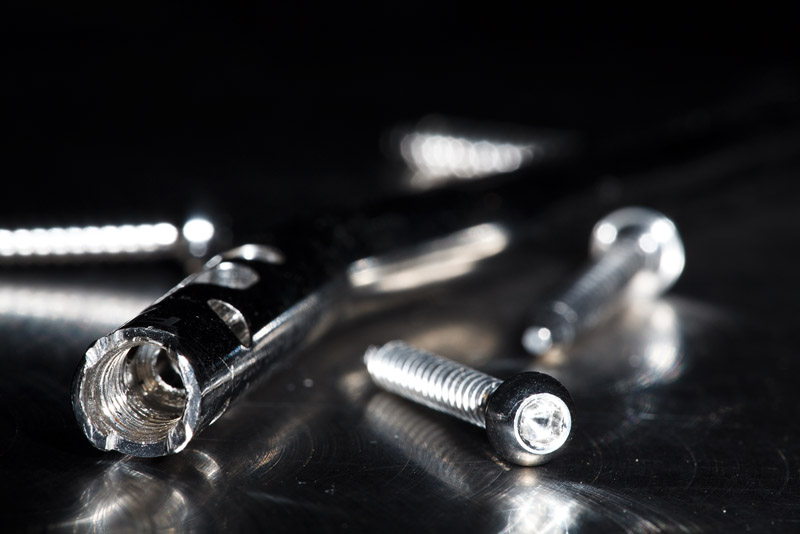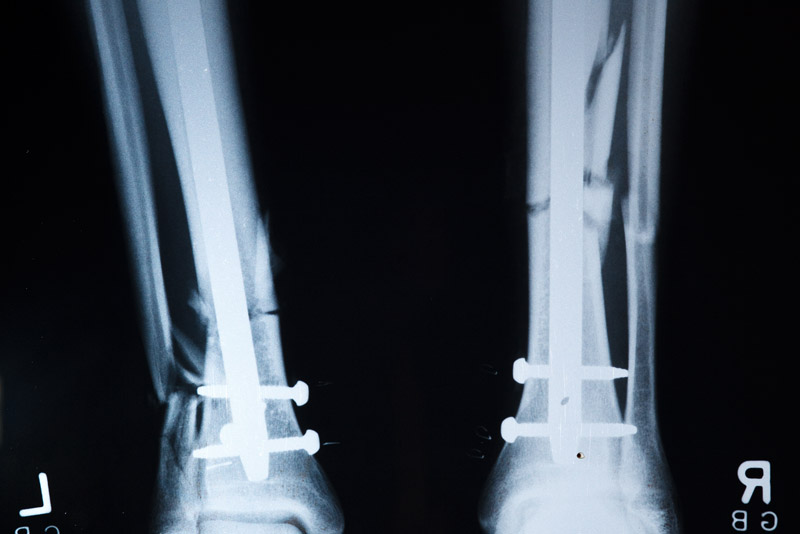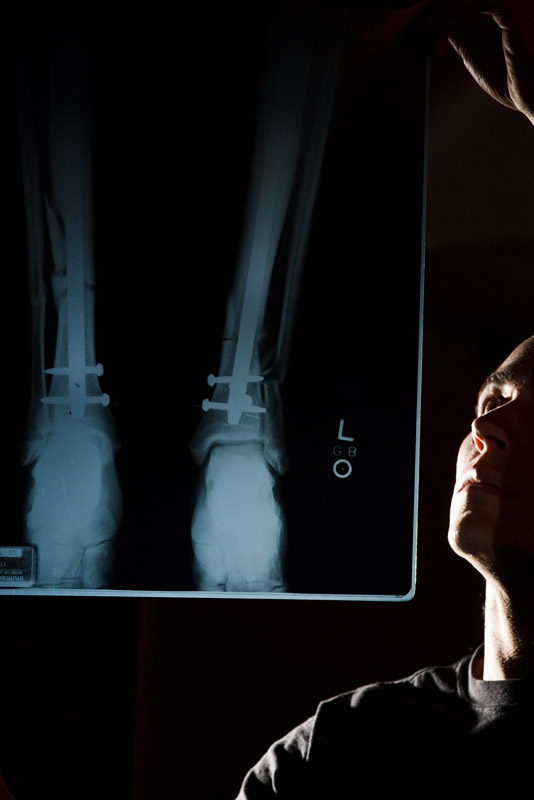
Screwed
In the closing months of 2001, the world is still reeling from 9/11, the tech bubble has already burst, and I am a senior at MIT. The fall semester is to be my last hard one; spring only holds one class and a thesis. My primary extracurricular concerns are beer, mozzarella sticks, and escaping the horrid east coast "snow" for something better to make turns on.
On January 8, 2002, I drive to Kirkwood with 3 friends, looking forward to a great Tuesday of snowboarding. The snow will be hard until late morning and the mountain is empty, so I elect to start the day on my race board, a Burton-made beast that's equal parts scalpel and cruise missile. To a large degree, it's a device that screams "does not play well with others," and that's a good part of why it's awesome. The feeling of riding this thing at speed is hard to describe, but I'll do my best.
Strap into thinly-veiled ski boots, and click them into plate bindings that sit at a 45-degree angle along the length of the board. Awkwardly scoot along to get on and off lifts and through loading zones. Formula 1 cars are not built to idle at stoplights, and this board is not built to do anything but haul ass. Get underway, then look a few turns ahead and pick a line, taking care to note locations of obstacles and snow irregularities, as well as to calculate the trajectories of other mountain guests. Pick up speed with your back to the mountain, riding on your heel edge, and then, when the time is right, engage hyperdrive. Bend your knees, load your quads, and steer with your shoulders. The board snaps hard from the heel edge to the toe edge, and the turn starts. You're downhill from the board, a seeming violation of the laws of physics, but the g-forces created between the board's edge and the snow suspend your body in mid-air over the run. Those forces build as the turn continues, your quads bearing the duty of keeping your torso from collapsing into the board. At the apex of the turn, your body is laid out over the snow from knee to hip to armpit to hand, and your dilated pupils watch the ridges of the groomed snow streak past faster than your visual cortex can keep up with. As the turn concludes, the g-forces subside, and your body re-enters the land of the living just long enough to load the tail of the board to set up that glorious weightless snap back to the heel edge where it all happens again. There's no slipping and no sliding and no "maybe let's go over here and check out this other spot," and by the time you've exceeded the speed limit of most highways with your face inches away from the snow, your legs are a quivering mess of jello, and the only evidence that you've struck is a series of deep well-defined trenches in the snow with gaps of many feet of wholly-undisturbed snow between turns. You are a ninja, and you've got about as much in common with the other snowboarders as a shark has with a sea full of goldfish. Welcome to the top of the food chain.
When it's right, it's one of the most pure experiences out there.
It's an addictive feeling, and I am giddy with caffeine-free anticipation to plug into it at Kirkwood. On our first run of the day, I survey an empty trail save for my three friends ahead of me and begin the process described above. Not even one turn in, and just beginning to pick up speed near the treeline, I watch another snowboarder exit the trees without looking uphill. He's about 15 feet in front of me, and the nature of committing to a turn on the race board gives me about half a second of realization that no quick maneuvering will be possible before the collision happens. The front of my board strikes the back of his binding, his first indication that I'm there. My legs stop instantly while my upper body continues on, and both tibias and fibulas experience about 200 times the force of gravity before they snap inside my boots (yes, I did the math). Before I slide to a stop, I know that both my legs are broken. As the waves of shock roll over me, I'm not yet able to realize that my life has changed. It will take years to come to terms with it, but the tenth of a second that it takes for my legs to go from whole to pieces will be a defining moment beyond any I've experienced to date.
The first hour or so is excruciating. Unable to medicate me at the mountain, the clinic staff mediates the battle between bone shards, sweet sweet shock, and blistering pain as best they can. They perform some rudimentary traction on my right leg, and it's from this particular batch of seconds that my all-time milestone of pain comes, still easily recalled to this day.
The ambulance ride brings Dilaudid, a heaven-sent gift of opioid escape.
I don't remember much of the hospital, probably a blessing considering the racks of power tools they have at standby. They move my kneecaps aside, drill into the top of each tibia, ream out the bone marrow, select titanium-vanadium rods to fit snugly down the length of the bone, pound them down, drill self-tapping screws through the bone and each rod, and staple me back together. I come to under the purvey of a morphine clicker, an interesting little device that teaches me a thing or two about chemical dependence over the course of three days. I'll be damned if I don't learn to wake up every seven minutes and fifty-five seconds to catch the 8-minute lockout on the thing before I go back to sleep.

Chunky
The next weeks bring bed and not much else. Once I'm able to be a little bit mobile, I can move around in a wheelchair; I'm to be 100% non-weight-bearing for 8 weeks. After returning to Boston, exceedingly grateful that my final semester will be a light load, I start to learn about accessibility in the old city: I can't make it two blocks to physical therapy without encountering multiple obstacles that are non-navigable in a wheelchair, and I'm also unable to enter my own house without being carried up or down the stairs. I also learn a few dark lessons about how people look at and act toward wheelchair users. After those 8 weeks of purgatory end and I'm able to use crutches (another 8 weeks), my world expands leaps and bounds thanks to a more nimble form of transportation. I'm still only allowed to bear weight evenly across my legs, so taking a step is out of the question. Hey, at least my arms are ripped.
Finally, desperately, I'm cleared to bear more weight, which comes with it the task of relearning how to walk.
The previous 4 months have been filled with sleepless nights and dreary days of longing for activity and recreation. However, it's not until the walking lessons begin that it really rings clear: something I've taken for granted since before my earliest childhood memories can be wholly unlearned in a trivial amount of time. Something as simple as self-ambulation is not a gift to be trifled with; it can be snatched away with the greatest of ease. It's in those weeks of relearning what balance is and how to move about without making the metal in me hurt that I make a promise to myself to never take mobility for granted. Every day I will make the most of it, whatever form it might take, and I will remain grateful for it as long as I have it.
It's during one of those sleepless nights (early on) that I discover a mental process that allows me to move healing energy down to my legs; I can feel healing happen in real time. It's a mild epiphany; a departure from the science-ruled world I've known all my life and from the engineering curriculum I've been ensconced in for four years.
The next year is relatively uneventful. The mild course load allows me to finish MIT without much trouble; a blessing considering the amount of physical therapy I'm doing. However, walking hurts, an attempt to run a quarter of a mile ends in some comically ginger hobbling, and so much as stubbing my toe sends vibrations up the rod in my tibia and makes my knee scream out in protest.
At the one year mark, the hardware gets removed.
I feel more than a little bit crazy to volunteer for more surgery, more bed rest, and more physical therapy. It's much better this time around, and it's all in the name of progress. The pain isn't as bad and the rehab is far easier; no wheelchair and only a few weeks of downtime. Snowboarding is wholly out of the question until at least the following winter; two full years off the snow and away from my beloved pastime and sole spiritual escape from the hustle and bustle of the world. As a bonus, I've now got a couple pounds of exotic metal in a bag to serve as a reminder of the whole ordeal. And two sets of gnarly scars.

Wolverine-style
Now with renewed spring in my step, the desire to return to the mountains burns stronger than ever, but there's a nagging doubt. After all, the last time I went snowboarding, look what happened! Along with my promise to myself to take full advantage of my new-found mobility, the desire to strengthen my legs to sustain the rigors of cliff drops and hard turns the following winter leads to an interesting proposition. I'll enter a triathlon, a little short local one, and if my legs survive that, surely they'll be ready to get back on the snow. After all, I swam and played water polo through high school, I've got a mountain bike that's fun to ride, and I do run a couple times a year, up to and including three miles!
The swimming and biking training isn't too bad, but running is a different story altogether. With substantial pain on board, the most I'm able to run before the race is a mile, and it ain't pretty. When the race rolls around, I'm counting on relying on pure determination to run the five miles, and that works out kinda OK, but it's some rather humbling moments on the bike where I'm passed by women in their 50s that really go to work on me. I'm wrecked and hooked, all at the same time.
Finally, the winter brings a return to the snow. The first few days are filled with abject terror anytime another skier or snowboarder is within 20 yards, but that fear subsides soon enough. A few storms into the season, I return to Kirkwood, and in addition to visiting The Spot, I take a spectacular high-speed tomahawking fall down a steep powder slope and come up whole. Confidence is regained!
Fast forward a few years, and changes have been happening left and right. Jobs come and go (all for the better), friends wax and wane, and I finally discover travel. My approach to sport shifts dramatically; both physical and mental games get raised a few bars. On the snow, I ride progressively harder and harder lines, terrain that used to scare me to even look at. In the world of triathlon, I come to relish the feel of competition and the process of improvement at increasingly difficult races. A fortunate combination of circumstance and opportunity takes me to New Zealand to live, further fueling the fire to explore more of the world and expanding my love for sport. I meet a nice Irish girl there, and she's alright, too. Fast forward a few more years, and changes and growth are still the name of the game.
If you've made it this far, hats off to you.
What's this all about? Well, there's no doubt that if that fateful day a decade ago had played out differently, it's not as though my life wouldn't have changed in the meantime. There's also no doubt that it wouldn't be the same it is today. And I'm not enough of a fatalist to think that my "bad day on my snowboard" set this exact course that I've followed for ten years thus far. However, the fundamental shift in perspective that it brought about has opened up paths and opportunities that would have remained shrouded from view had I not been fortunate enough to experience it.
I'd also like to state that, really, I had it pretty easy. There are FAR worse injuries one could sustain, FAR less brilliant surgeons (thank you from the bottom of my heart, Dr. Rupp), and FAR less complete recoveries. Maybe it was a wake-up call I was in dire need of. In any case, I certainly could have reacted to it far differently. Done the victim thing. But deep down, there was a sensation of warm and fuzzy opportunity that I couldn't ignore, and it's to the point now where, ten trips around the sun later, I'm glad it went down the way it did. I wouldn't go as far as to recommend that you go step in front of a bus to bask in the glory of some life-changing surgeries, but if it happens, make the most of it.
-
5 comments:
Eliot, what an amazing story. I feel foolish that I had no idea. Only our mind can hold us down. Way to rock it my friend.
Thanks Aimee :). You're exactly right about the mind!
Eliot, I just read your blog entry and remember living those days through you with your Dad, as he reported the terrible tragedy and the progress of your recovery to us. You are so amazing and your story is truly inspiring. I am sending it now to all your cousins so that they may also be inspired. Congratulations on 10 years of surviving and on your ability to see the positive in it. Thanks for sharing! Love, Aunt Nancy
Proving that old saying "tough times never last..." ;)
Happy New Year my friend.
Thanks Nancy; nice to hear from you.
Pete! Hope the rest of your trip was grand and that summer eventually comes to NZ :)
Post a Comment